-
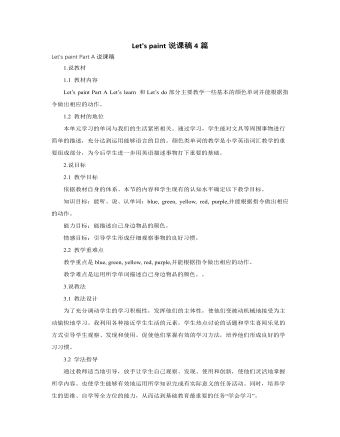
人教版新课标PEP小学英语三年级上册Let's paint说课稿4篇
本课教学从激发学生的兴趣入手,引导学生由词到句,循序渐进地达到学习目标,整个教学体现全员参与,体现合作探究,体现生活实践,在活动中开始,在情景中操练,在运用中创新,充分发挥学生的自主性,创造性。在整堂英语课堂教学中最大限度地激发学生的学习兴趣,使小学生在一节课的时间里始终保持高昂的学习状态。产生事半功倍的效果。 三、说教学手段 小学生的形象思维在其认识过程中占主导地位,三年级学生刚刚接触英语,学习一般靠直觉和体验,不善于把握语言规律,以直观的形象思维为主,对语言记忆以机械记忆占大多数,这就要求教师采用多样的教学手段,使课堂教学生动活泼,吸引学生,寓教于乐。1. 在小学英语课堂教学中要尽量多的采用实物情景进行直观的教学,这样做既符合小学生的认知规律,又能吸引他们的有意注意。

人教版新课标PEP小学英语三年级上册Look at Me说课稿4篇
5. 文化目标:本单元的文化知识是西方的万圣节(10月31日),万圣节是西方孩子们最喜欢的节日之一。他们身穿不同的戏装,戴上千奇百怪的面具,在街区走来走去。不少孩子手中还提着一盏“杰克灯”(Jack-o’-lantern)/南瓜灯,这种灯的做法是先把南瓜挖空,在南瓜上挖出眼睛、嘴和鼻子,贴上蓝色纸,制成南瓜灯,当中点上一支小蜡烛,放出幽灵似的蓝白光。孩子们常常从一家走到另一家,在人家门前高喊:“你想挨捉弄,还是款待我们?”(Trick or treat!)如果主人不给糖果或零钱,这些孩子就会捉弄他(她)。他们有时在门把手上涂上肥皂,有时把人家的猫涂上颜色。这些恶作剧常令大人啼笑皆非。当然,大多数人家都非常乐意款待这些天真的小客人。在晚上,人们常举行晚会,孩子和大人都身穿不同服装。万圣节人们常常做一些传统的游戏和活动,像:试图摘悬挂的苹果,算命,听有关鬼的故事。学校也经常举行晚会或化装游行。
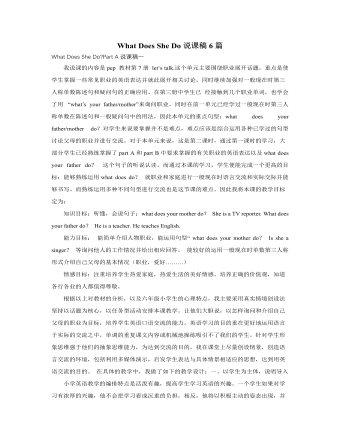
人教版新课标PEP小学英语六年级上册What Does She Do说课稿6篇
My Home本身就是一个与生活有着紧密联系的话题。我从这一点出发,紧紧围绕生活来开展教学。在Write and say这部分内容的教授中,我通过介绍我自己房间里的家具,如:Th is is my room, you can see a window、a door、a desk、a chair、a bed, Oh, It is a nice room . I like it,引出句型What can you see in my room ?引导学生说:I can see a window、a door、a desk、a chair、a bed, Oh, It is a nice room . I like it,然后安排同桌间拿出自己准备的房间图片,根据房间图片,相互之间询问。要求学生简单描述自己的房间,结合学过的语言描述房间内家具陈设的名称、特征等。学生看着自己亲手绘制的房间图片,亲切感、生活的真实感都一股脑儿地涌上心头。此时他们用学习的语言进行交流的愿望也就特别强烈。 最后、渗透情感教育 让学生通过谈论自己的房间,培养学生对家的热爱之情;我在这样的教学中渗透了学生热爱家庭的情感教育:因为,家是我们每个人永远的港湾,我们要爱家,爱护家里的每一样家具。
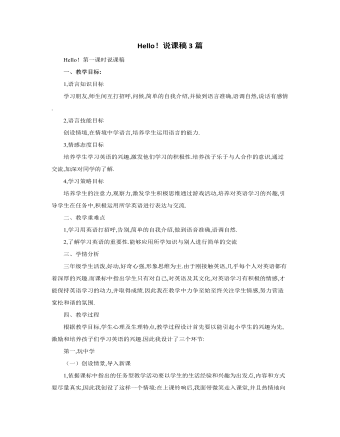
人教版新课标PEP小学英语三年级上册Hello!说课稿3篇
新授环节,教师引导语,“今天我们要与文具交朋友,看看他们是什么呢?看谁认识的朋友又快又准又多。”说完之后利用自制实物有声教具呈现文具的发音,方法是用识别笔点钢笔上的识别码,让钢笔自己说出:“Hello. I’m a pen. pen, pen, pen”学生对实物会说话非常好奇,极大地吸引孩子们的注意力,从而细心倾听它叫什么,从而记住文具英语的读音,大大调动学习的积极性及学习兴趣。对于四个单词的教学采用同样的方法。突破难点上采用分音节的方法教,如eraser, rayon的发音,使学生听到清晰的发音,然后再整体读,帮助学生更好的记住单词的读音。我们在课堂上创设一个有声有色的教学情景,再现一个现实生活的真实氛围,制作很多会说话的教具,这样就会吸引学生的注意力,激发他们对英语的兴趣。有了智能语音教具系统,这一切就很容易做到。
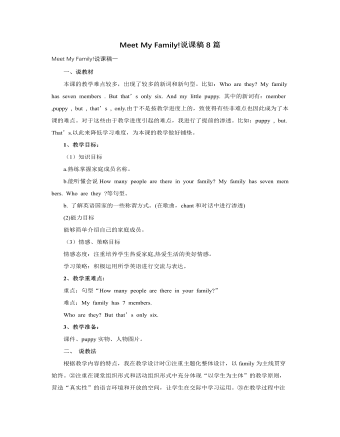
人教版新课标PEP小学英语四年级上册Meet My Family!说课稿8篇
一、说教材:我所上的是PEP3 Unit6 Meet my family B Let’s talk 部分。主要的学习内容是:1.What’s your mother/father? He’s/She’s a …. 2. He looks strong. They look young. 3.Is this your …?Yes, he/she is. No, he/she isn’t. 同时,在完成教学大纲所规定的教学内容后,根据学生的掌握情况,在学有余力的情况下,适当拓展学习内容,让学生结合自己的家庭照片,把自己的家人介绍给自己的朋友。二、说教学目标:1.能听懂、会说本课对话,并能在实际情景中运用。2.能听、说、认读本课句型Is this your father ? What’s your mother ? He looks strong .They look young .3.理解、会说Let’s chant部分的内容。三、说重点:1.能听、说、认读句型:Is this your …?What’s your …?He looks ….四、说难点:1.能够正确认读句型:They look young. Are they farmers.五、说教学过程:一、热身复习。1.Let’s doAct like a teacher/baseball player/driver/doctor/farmer/nurse.(课前播放Let’s do 部分的音乐,让学生进入教室跟着音乐边说边做。既起到了复习上节课所学单词的作用,又为新的引出奠定了基础。)
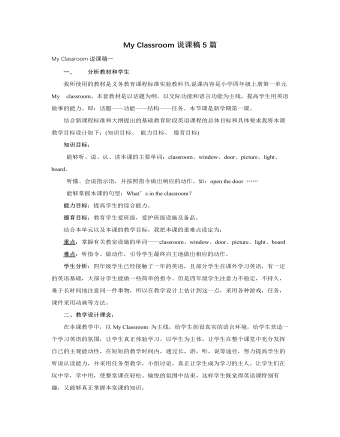
人教版新课标PEP小学英语四年级上册My Classroom说课稿5篇
一 说教材内容本课时的内容是四年级上册第一单元的第4课时,即Let’s learn, Let’ play, Let’s find out和Story time。本课为单词教学,用已学的有关教室设施的单词来引出5个新单词,并用TPR教学法来巩固和操练单词。通过理解故事,来了解学生对本单元知识的落实情况。二、 说教学目的在认真剖析教材的基础上,我针对学生实际,将本课时的教学目的确定如下:1、知识目的:能够听、说、认读本课时的重要单词,能够在教师的领导下完成游戏。能够完成Let’s find out中找字母的任务。能听懂本单元的故事。2、能力目的:能够用英语简略描写自己的教室,能够说出教师中设施的颜色等。3、情绪目的:重视合作精力,激发学生学习英语的兴趣,使学生建立学习英语的信念。三、说教学重点和难点1、重点:本课时需要重点控制另外四个有关教室设备的单词:computer, teacher’s desk, fan, wall, floor。
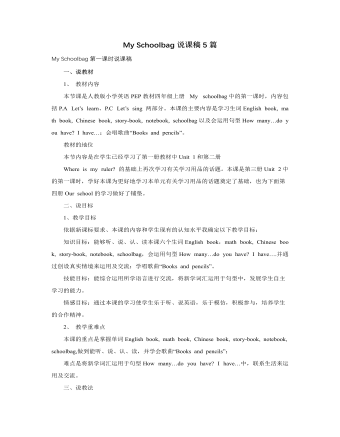
人教版新课标PEP小学英语四年级上册My Schoolbag说课稿5篇
(1)Sing a song.由于老师是借班上课,师生间难免会由于陌生而产生距离,所以选一首大家都熟悉的歌曲可以把师生间的距离拉近。(2)通过听指令做动作(如:point to the window , point to the door ….)等复习第一单元的知识,同时为进入本单元的schoolbag作铺垫。第二步:. Presentation 激情引趣,学习新知(1)由point to the bag 导入课题(板课题) 并引导学生说。(2)多媒体课件呈现所学新单词。学习单词按易到难,由浅入深原则逐一学习。先从大家熟悉的English book入手,然后到Chinese book, math book, notebook ,。由于story-book比较难发音,因此安排在最后。(3)通过图片、单词卡片、课本让学生反复指认这些单词。(4)Guessing game .让学生快速抢猜单词。(5)教学句型:How many …do you have? I have….通过学生与老师 ,老师与老师之间的对话来加强学习,在同学们熟悉单词后,引导他们加入How many …do you have? I have….进行操练。
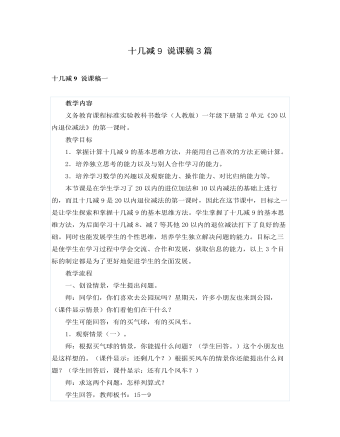
人教版新课标小学数学一年级下册十几减9 说课稿3篇
2.通过动手操作、交流算法,使学生经历十几减9的过程,知道想加算减、破十法、连减等多种计算方法,理解算理,掌握算法。能正确计算。3.在学习过程中,培养学生简单的推理能力、表达能力和解决问题的能力。教学重点:掌握十几减九的计算方法,正确、熟练的进行计算。教学难点:经历十几减九的过程,感受算法多样化,理解算理。我的教学过程分为四个大环节,其中第二环节是本节课的重点环节,我又设计了五个小层次:下面我就具体说一说我的教学过程。一、创设情境,复习导入(3分钟)我以元旦快到了,班里要举行游艺活动这样的情境进入练习。【设计意图:在带着学生走向新知之前,再现与新知有关的原认知,复习前面所学的20以内的进位加,数的分解和组成及10减几等知识,为今天学习新课做好铺垫。】接着我以元旦游艺活动,班里要用气球布置教室来引入新课。【设计意图:以学生感兴趣的身边问题吸引他们的注意力,激发兴趣,并巧妙引出新课。】
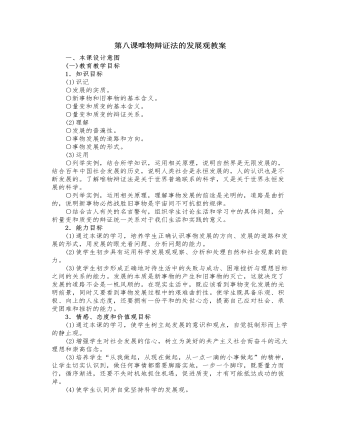
人教版高中政治必修4第八课唯物辩证法的发展观教案
1973年4月的一天,一名男子站在纽约的街头,掏出一个约有两块砖头大的无线电话,并开始通话。这个人就是手机的发明者马丁,当时他是摩托罗拉公司的工程技术人员。这是当时世界上第一部移动电话。1985年,第一台现代意义上的可以商用的移动电话诞生。它是将电源和天线放置在一个盒子里,重量达3公斤。与现代形状接近的手机诞生于1987年,其重量大约750克,与今天仅重60克的手机相比,像一块大砖头。此后,手机的“瘦身”越来越迅速。1991年,手机重量为250克左右。1996年秋,r出现了体积为100立方厘米、重量100克的手机。此后,又进一步小型化,轻型化,到1999年就轻到了60克以下。手机的体积越来越小,但功能却越来越多。以前的手机是用来通话的,现在的手机是用来享受的。今天,手机可以是相机、游戏机、音乐播放器、信用卡、电影院……手机带来的不仅仅是通信方式的改变,更是生活方式的变革。
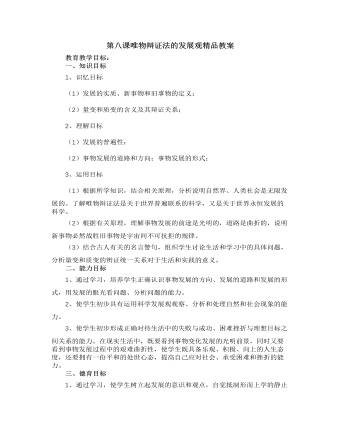
人教版高中政治必修4第八课唯物辩证法的发展观精品教案
2、理解目标(1)发展的普遍性;(2)事物发展的道路和方向;事物发展的形式;3、运用目标(1)根据所学知识,结合相关原理,分析说明自然界、人类社会是无限发展的。了解唯物辩证法是关于世界普遍联系的科学,又是关于世界永恒发展的科学。(2)根据有关原理,理解事物发展的前途是光明的,道路是曲折的,说明新事物必然战胜旧事物是宇宙间不可抗拒的规律。(3)结合古人有关的名言警句,组织学生讨论生活和学习中的具体问题,分析量变和质变的辨证统一关系对于生活和实践的意义。二、能力目标1、通过学习,培养学生正确认识事物发展的方向、发展的道路和发展的形式,用发展的眼光看问题、分析问题的能力。2、使学生初步具有运用科学发展观观察、分析和处理自然和社会现象的能力。3、使学生初步形成正确对待生活中的失败与成功、困难挫折与理想目标之间关系的能力。
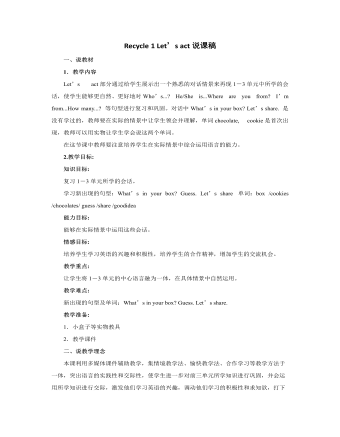
人教版新课标PEP小学英语三年级上册Recycle 1 Let’s act说课稿
小学生学习的主动性,大多取决于兴趣,他们充满好奇,对显而易见的实物和直观信息敏感性强、接受快。借助多媒体计算机CAI辅助教学,把所学内容更加直观地表现出来。4.游戏式复习热身,体现课堂教学开放性利用做游戏的形式进行旧知识的复习,既消除了上课初老师和学生之间的陌生感,又激发了学生学习兴趣,同时又对前面所学内容进行了巩固。5.综合运用“愉快教学”、“情境教学”、“合作学习”等多种教学方法,降低学习难度,活跃课堂气氛。6.展开活动式教学,设计各种形式为教学服务的活动,让学生在学中乐,在乐中学,不断强化知识的巩固记忆。7.设置评比台,及时评价小组及个人表现,鼓励学生积极参与学习活动。四、说教学流程1.拍手游戏热身2.师生问好,交流,对第一页内容复习3.引入第二页内容,学习新单词、句型4.趣味操练
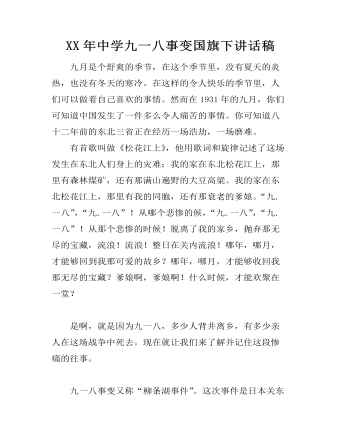
XX年中学九一八事变国旗下讲话稿
九月是个舒爽的季节,在这个季节里,没有夏天的炎热,也没有冬天的寒冷。在这样的令人快乐的季节里,人们可以做着自己喜欢的事情。然而在1931年的九月,你们可知道中国发生了一件多么令人痛苦的事情。你可知道八十二年前的东北三省正在经历一场浩劫,一场磨难。有首歌叫做《松花江上》,他用歌词和旋律记述了这场发生在东北人们身上的灾难:我的家在东北松花江上,那里有森林煤矿,还有那满山遍野的大豆高粱。我的家在东北松花江上,那里有我的同胞,还有那衰老的爹娘。“九.一八”,“九.一八”!从哪个悲惨的候,“九.一八”,“九.一八”!从那个悲惨的时候!脱离了我的家乡,抛弃那无尽的宝藏,流浪!流浪!整日在关内流浪!哪年,哪月,才能够回到我那可爱的故乡?哪年,哪月,才能够收回我那无尽的宝藏?爹娘啊,爹娘啊!什么时候,才能欢聚在一堂?是啊,就是因为九一八,多少人背井离乡,有多少亲人在这场战争中死去。现在就让我们来了解并记住这段惨痛的往事。
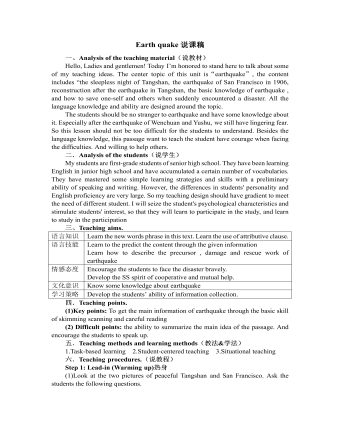
人教版高中英语必修1Earth quake说课稿
(4)Finally, I will ask the SS what this sentence mean:It is always calm before a storm.Purpose: attract the SS attention and bring them into discussionStep 2: Pre-reading 读前Here, I will do the second question in pre-reading first. I will use the method of brainstorming to ask the SS what will happen before an earthquake; and list the phenomenon on the table. 2. Then I will show the SS the picture of abnormal phenomenon, at the same time, encourage the SS to describe.3、finally, I will summarize these phenomenon4、Do the first question in the pre-reading , Imaging your home begins to shake and you must leave it right away. You have time to take only one thing. What will you take? Why?Purpose: help the SS to get further understanding of the topic and stimulate their interests.Step3: While-reading 阅读(1). Skimming Read the text quickly and catch the meaning of the first and second sentence of each paragraph. Predict the meaning of new words(2).scanning(找读)A. Read the text again. Do the following question.1. When and where were the strange things happening?2. What are they?3. Why did the text say the world seemed to be at an end?4. How was the city destroyed after the quake?5. When did the second quake hit the city? What was the result of that?6. Who came to help Tangshan first? And how?B. Work in pairs to discuss the question.
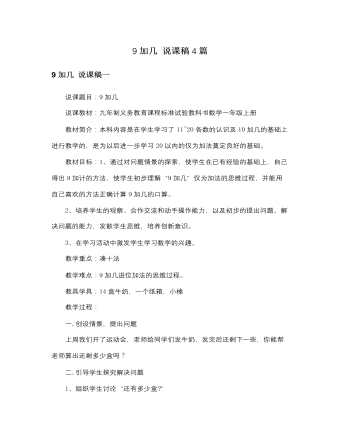
人教版新课标小学数学一年级上册9加几 说课稿4篇
·演示口算过程2、解决“踢毽的和跳远得各有多少人?”a、引导学生观察画面,并提出问题。b、 让学生在画面中收集数据。c、 学生独立列式,并让学生将是怎样计算出结果的。3、分利用教材资源,尝试提出新问题。a)收集信息及数据。引导学生观察画面:运动场上除了踢毽和跳远之外,还有哪些比赛项目?参加这些项目比赛的各有多少人?b) 小组交流,提出要解决的问题。教师问:你还能提出哪些加法计算的问题?小组讨论后发表意见。c)解决同学们提出的问题。d) 小结。教师提问:仔细观察黑板上的算式,他们的第一个加数是几?(引出课题)计算9加几的题目有很多种方法,你喜欢哪一种就用哪一种.4、 反馈练习游戏:小精灵算式。你想上来摘哪道就摘拿道。拿到算式的学生进行计算,没拿到算式的同学做裁判
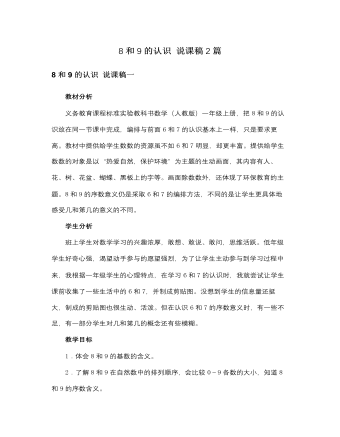
人教版新课标小学数学一年级上册8和9的认识 说课稿2篇
教材分析义务教育课程标准实验教科书数学(人教版)一年级上册,把8和9的认识放在同一节课中完成,编排与前面6和7的认识基本上一样,只是要求更高。教材中提供给学生数数的资源虽不如6和7明显,却更丰富。提供给学生数数的对象是以“热爱自然,保护环境”为主题的生动画面,其内容有人、花、树、花盆、蝴蝶、黑板上的字等。画面除数数外,还体现了环保教育的主题。8和9的序数意义仍是采取6和7的编排方法,不同的是让学生更具体地感受几和第几的意义的不同。学生分析班上学生对数学学习的兴趣浓厚,敢想、敢说、敢问,思维活跃。低年级学生好奇心强,渴望动手参与的愿望强烈,为了让学生主动参与到学习过程中来,我根据一年级学生的心理特点,在学习6和7的认识时,我就尝试让学生课前收集了一些生活中的6和7,并制成剪贴图。没想到学生的信息量还挺大,制成的剪贴图也很生动、活泼。但在认识6和7的序数意义时,有一些不足,有一部分学生对几和第几的概念还有些模糊。

人教版高中英语必修2Cultural Relics说课稿2篇
Ⅲ. Analysis of the teaching material:The topic of this unit is cultural relics. Students are quite interested in topics about different cultures around the world. This is the second period of the whole unit. As a reading class, the passage mainly talks about the history of the amber room (how it was made, sent as a gift, lost and rebuilt).According to the new national curriculum, when teaching reading, much emphasis should be put on training the students’ reading skills.Ⅳ. Teaching objectives1. Language objectives:1) Students are required to master the key words and phrases occurred in the passage (e.g. amazing, decorate, belong, in return, less than etc.)2) Students are required to learn the attributive clause and acquire the sentence pattern.2. 1) Students are required to describe a certain thing by using the new sentence patterns.2) Students are required to master two kinds of reading skills—skimming and scanning, and learn to use them in their daily reading.3. 1) Students are required to know the history of the amber room.2) Students are required to appreciate cultural relics and understand the importance of protecting them.Ⅴ. Teaching important and difficult points1) the new words, phrases, and sentence pattern in the course of reading.2) Teaching difficult point: Help the students master two kinds of reading skills—skimmingand scanning and learn to apply them in daily use.Ⅵ. Teaching methods:Task-based method & Top-down model Ⅶ. Teaching aids: PPT, pictures, blackboard Ⅷ. Teaching procedure:

人教版高中英语必修4Theme parks说课稿3篇
The oldest and the most popular park in the worldenjoy the exciting activities thereget close to the life-size cartoon characters like Mickey Mouse and Donald Duck Step 3 Pre-reading1.What do you suppose a theme park is ?2.What do you think you can see in a theme park?(1.It is a kind of amusement park which has a certain theme – that the whole park is based on. 2.buildings, castles, statues, rare animals and birds, and so on.) Step 4 Reading ----- Theme Parks –---- Fun and More Than Fun1.Predict : Read the title and the pictures on P. 34 and PredictWhat is the meaning of the title “Theme Park – Fun and more than fun”?(The title means that theme parks are fun to visit, but that they can also be educational and can offer useful information.)2.Skimming Fast read and answer:What activities can we take in a theme park?Amusement park: Bumper car Merry-go-round slide bungee jumping Free-fall rides Horror films Pirate ship Ferris wheel roller coaster3.Scanning Read again and you will find various theme parks are mentioned in the passage . Then what are they ?Theme parks: Sports theme park History theme park Culture theme park Marine or Ocean theme Park Future park Science theme park Disneyland4.Careful reading and find the main idea of each paragraph:THEME PARKS---- entertaining/ educationalPara.1 Traditional parks are places to go for relaxation and to have time away from our busy lives.Para.2 Theme parks are different They’re large and full of things to do, see and buy.Para.3 Theme parks are built around a single idea or theme. One example is a sports park.Para.4 Another kind of theme park is historical more and cultural and can be educational.Para.5 Disneylandwas the first theme park. It is based on the fantasy life and characters of Disney’s films.Para.6 Some examples of educational theme parks include sea world parks and science parks.

人教版高中英语必修5First aid说课稿6篇
In this class, I have 3 teaching aims, that is, knowledge aims, ability aims and emotion aims.1) Knowledge-Teach students new words and expressions, such as temporary, bleed,sprain choke, first aid, fall ill and so on.-Enable students to have a better understanding for some basic knowledge of first aid.2) Ability-Train students’ speaking, reading and writing abilities by different teaching activities, such as skimming, comprehending, team work, role play, retelling and writing.-Develop students’ reading strategy on how to move general idea to specific information.3) Emotion-Promote students’ awareness of giving first aid.- Cultivate students’ creativities.Then let’s come to my teaching methods and activities.III. Teaching methods and activities:To achieve different teaching aims, various kinds of teaching methods and activities will be adopted throughout this period, such as TBL (task-based learning), skimming, team work, brainstorm and others, which can offer students opportunities to fulfill tasks in which they can use language to achieve a specific outcome.IV. Teaching aids:Computer and blackboardV. Teaching important points:1) Make students have a clear mind for the structure of the text.2) Help students understand the theme of the text.VI. Teaching difficulties:1) So many new words may affect students’ understanding.2) How to get students to know about the functions of the skin and thecauses, characteristics and treatments for different degree burns,and the knowledge about giving first aid. VII. Blackboard design:

人教版高中英语必修4Body Language说课稿4篇
Textbook: Senior English for China (Book 4), by Liu Daoyi Time Allotment: 1 period (40 minutes)Date: March 20, 2014Teaching aids: blackboard, Multi-media, Power Point, chalk I. Text Analysis (教材分析)This unit is about body language, and the text selected in the reading part demonstrates the difference and similarity of body language in many parts of the world. Through learning this passage, students are required to raise their awareness of using body language in different parts of the world. As body language is closely related to our daily life, it is easy to arouse students’ interest in learning this text. Reading skills and speaking training are designed around the text.II. Teaching Objectives (教学目标)By the end of the lesson, students will be able to:1. Language Skill Objective(语言技能目标): develop reading ability (skimming and scanning)as well as speaking ability.2. Cultural Knowledge Objective(文化知识目标): know about the cultural differences of using body language.3. Affective Objective(情感目标): increase students’ awareness of using body language correctly in different cultures. III.Teaching Focuses and Difficulties(教学重点和难点)1. Teaching Focuses(教学重点): the difference and similarity of body language in many parts of the world.2. Teaching Difficulties(教学难点): develop students’ reading abilities of skimming and scanning and ask the students to show their opinions with fluent English.

人教版高中英语必修2Computers说课稿3篇
一. 教材分析1. 本单元的中心话题是“计算机(Computers)”,内容涉及计算机的发展历史,计算机的应用等。本节课是该单元的第一课时,我将Warming up, Pre-reading and Comprehending这四部分整合为一节精读课。其中。Reading部分是题为WHO AM I?的文章,以第一人称的拟人手法介绍了计算机发长演变的历史和计算机在各个领域的应用,其主旨是表达计算机的发展变化之快以及在生活中用途之广。而Warming up部分以图片的形式展现了计算机的发展历程;Pre-reading中的问题和排序分别是为了预测语篇的内容和测试学生对计算机历史了解的情况;Comprehending则通过各项练习训练学生的阅读技能,从而加深对文章的理解。可见这几部分是一个有机的整体。2. 教学目标:1) 语言目标:重点词汇及短语:abacus, calculate, calculator, PC, laptop, PDA, robot, analytical, technological, universal, mathematical, artificial, intelligent, network, explore, in common, as a result.重点句子:a. My real father was Alan Turing, who in 1963 wrote a book to describe how computers could be made to work, and build a “universal machine” to solve any mathematical problem.

